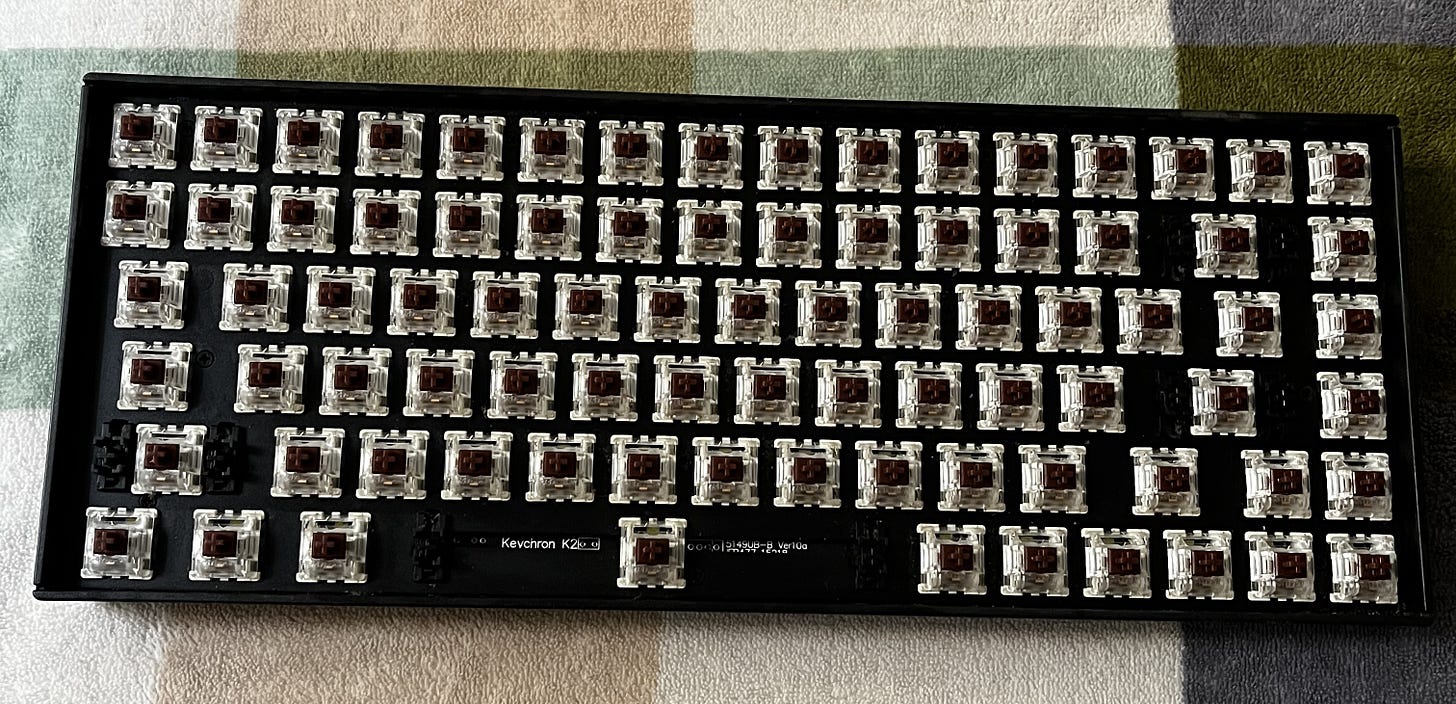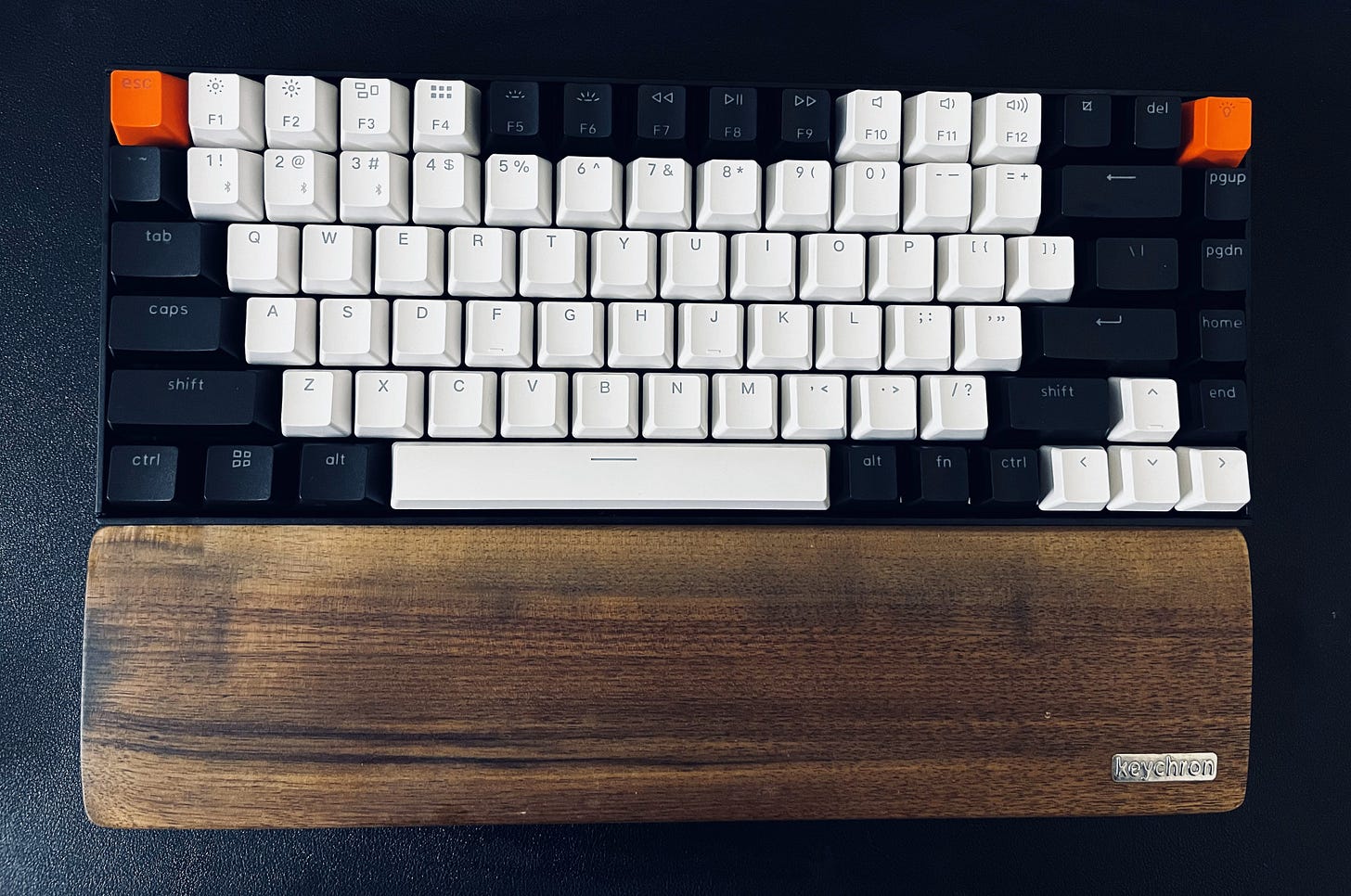Cleaning mechanical keyboards is my favorite cleaning activity!
Keychron, gotta clean 'em all! 🎶
Newsletter Update ✨
Before we get to this post, I wanna share a quick update! Notice something different in the URL? That’s right, I got a custom domain for this newsletter, yaay! ✨
In other news, the posts are now neatly organized into categories hehe.
On to the post now! 👇
There’s no escaping chores. We all have to do it, delegate it, or ignore it (won’t recommend though). One of the mundane chores one has to do is cleaning the household and you know, the things around you in general. While I won’t call myself a cleaning freak, I prefer having my surroundings tidy.
Although I’ve been having ups and downs in my cleaning journey, I overlooked one aspect that was right in front of me — cleaning my mechanical keyboard. My keyboard of choice is the Keychron K2 V2. I bought it a few years back and have been loving the experience.
After postponing a few days, I finally decided to do it and as it turns out, it might be my favorite cleaning activity. Here’s how it went:
Stage 1: Preparation
I collected everything I wanted to clean the keyboard. Since my keyboard’s cleaning spray is not here, I relied on an alternative (more on this later). Stuff that came in handy:
Mechanical keyboard (duh!)
Cotton ear buds
Tissues
Microfiber cloth
Cleaning liquid
Stage 2: Removing keycaps
Repairability is one of the perks of owning a mechanical keyboard. It’s possible to easily remove keycaps or even swap them for new ones. For the uninitiated, a keycap refers to the plastic thingy that is placed on top of a keyboard’s switch. You could call it the front end of a keyboard, in a way.
Keychron bundled a keycap puller in the package while shipping the keyboard. Thanks to that, I could easily remove the keycaps from the board. During the process, it almost felt like I’m a dentist performing a root canal surgery.
One other way to do this is to manually pull each keycap. It’s doable, but not efficient. In case you’re wondering, here’s how the keyboard looked after removing the keycaps.
I used cotton earbuds to carefully clean all random residual particles (trust me, it looked really nasty :( ) and the process took around 15 minutes. Now we get to the time-consuming part, cleaning keycaps.
Stage 3: Spray, wipe, dry, repeat
I typically use a dedicated spray for cleaning keycaps, but not this time. Having realized that I left the spray back home, I was thinking of alternate solutions. That’s when it hit me, I happen to have a cleaning liquid here — Colin Glass and Multisurface Cleaner for cleaning mirrors.
Although Colin let me down the first time, I was ready to give it another shot. Don’t we all deserve second chances in life, after all?
To my surprise, Colin worked exceptionally well while cleaning the keycaps. I sprayed on all keycaps and wiped it off with the microfiber cloth.
Stage 4: The result! ⌨️
After roughly 45 minutes, the keyboard was as good as new! This should do for another three (or more 🙈) months.
Drumrolls 🥁, here’s the ✨result ✨:
How fast can you type?
Since we’re on the subject of keyboards, I want to know how fast you can type. Not sure how many words you are capable of typing in a minute? Fret not, enter Monkeytype, an aesthetic typing test website.
I used to average around 95 - 100 WPM, but as of this writing, I scored 83 WPM on the laptop keyboard and 70 WPM on the Keychron K2 V2 (ironic, but yeah. It is what it is). Lemme know your speed in the poll below!
Maybe not? ¯\_(ツ)_/¯
I drafted this newsletter a couple of days back, but something happened today — I bought a new cleaning mop. Not the regular one, a fancy one with a dedicated bucket and wringing mechanism.
Pro tip: Use a chair with rolling wheels while mopping if you’re lazy.
I’m loving it so far. Perhaps it’s because I’ve started applying the boots theory to my purchases. For the uninitiated, boots theory essentially urges people to spend money on quality stuff for better ROI.
Here’s a relevant excerpt of boots theory from Terry Pratchett’s 1993 book Men At Arms:
The reason that the rich were so rich, Vimes reasoned, was because they managed to spend less money.
Take boots, for example. He earned thirty-eight dollars a month plus allowances. A really good pair of leather boots cost fifty dollars. But an affordable pair of boots, which were sort of OK for a season or two and then leaked like hell when the cardboard gave out, cost about ten dollars. Those were the kind of boots Vimes always bought, and wore until the soles were so thin that he could tell where he was in Ankh-Morpork on a foggy night by the feel of the cobbles.
But the thing was that good boots lasted for years and years. A man who could afford fifty dollars had a pair of boots that'd still be keeping his feet dry in ten years' time, while the poor man who could only afford cheap boots would have spent a hundred dollars on boots in the same time and would still have wet feet.
Recommended Reading: Understanding the 'Boots Theory' of socioeconomic unfairness — Moneywise.
Anyway, only time will tell if there’s a new favorite cleaning activity in town. Until then, cleaning mechanical keyboards takes the crown.
Treat outlet 🍨
If you (still) like browsing twitter dot com, Harpy is a good client on Android (no DMs though). The developer gave up on the app and listed the premium version for free due to the Elon-owned company’s controversial API pricing announcements.
The app still works and you can check it out from Play Store. I like the custom themes option and even made one myself (get in touch with me if you’re interested to check that out). Enjoy while it lasts!
Before I wrap up, I want to leave y’all with a song recommendation. Here’s a song I came across a couple of weeks back. Hope you like it. :)
Until next time! Hearts if you liked it, subs if you loved it!
Clean regards,
Subin




